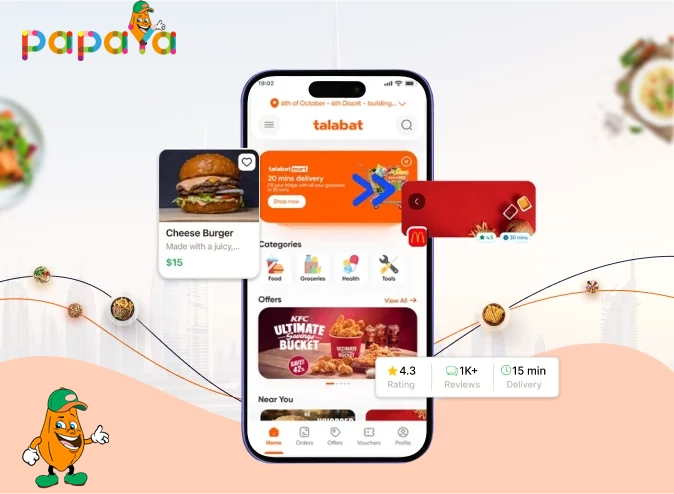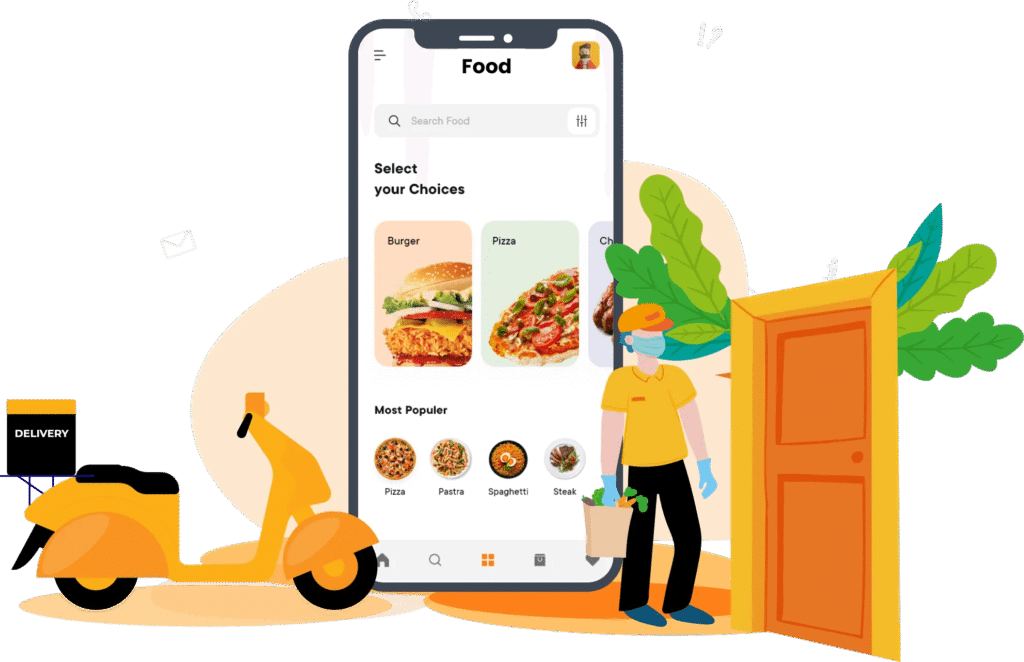
Table of Contents
ToggleIntroduction to Talabat Clone Apps
In recent years, the on-demand food delivery industry has witnessed exponential growth, driven by the increasing demand for convenience and efficiency. One of the most prominent players in this market is Talabat, a popular food delivery platform that has successfully catered to a diverse customer base. As a result, the concept of Talabat clone apps has emerged, offering entrepreneurs a viable opportunity to enter this lucrative sector. These clone apps are designed to replicate the essential features and functionalities of the original Talabat platform, aiming to create an equivalent user experience.
Talabat clone apps serve as an effective solution for businesses seeking to launch their own food delivery services without starting from scratch. By leveraging the core functionalities offered by Talabat, such as user-friendly interfaces, efficient order management systems, and secure payment gateways, entrepreneurs can benefit from an established model that streamlines the development process. This not only saves time but also minimizes the risks typically associated with app development.
The growing popularity of Talabat clone apps can be attributed to the changing consumer preferences and lifestyle shifts. With an increasing number of individuals opting for food delivery services over traditional dining options, there is a significant market opportunity for startups and established businesses alike. These applications are not limited to region-specific offerings but can be easily customized to cater to local tastes and preferences, making them appealing to a broader audience. Moreover, with advances in technology, the potential for incorporating innovative features such as real-time tracking, personalized recommendations, and loyalty programs enhances the user experience further.
In essence, Talabat clone apps represent an essential trend in the food delivery market, providing a robust framework for launching swift and efficient services that cater to the evolving demands of consumers.
Market Analysis and Trends in Food Delivery Apps
The food delivery app industry has undergone significant transformations over the past few years, becoming a pivotal segment within the broader e-commerce landscape. The surge in demand for food delivery services is largely attributed to changing consumer behaviors influenced by lifestyle shifts, particularly following the COVID-19 pandemic. Statistics reveal that online food delivery markets are expected to reach unprecedented growth, with forecasts estimating a compound annual growth rate (CAGR) of around 11.51% from 2023 to 2030. This trend underscores the lucrative opportunities associated with developing a Talabat clone app.
Moreover, the demographic insights into user preferences indicate that millennials and Gen Z are the primary drivers of the app economy in the food sector. These demographic groups exhibit a strong inclination towards convenience and digital solutions. Research suggests that around 60% of this audience prefers ordering food via apps rather than traditional methods, further solidifying the argument for businesses to consider entering this market. As the appetite for such services continues to rise, investing in food delivery app development becomes increasingly attractive.
The competitive landscape of food delivery apps reveals both challenges and opportunities. Major players like Uber Eats, DoorDash, and the original Talabat dominate the market; however, their presence creates a ripe environment for new entrants. By leveraging emerging technologies such as artificial intelligence, machine learning, and real-time tracking, a Talabat clone app can differentiate itself from competitors. These technologies enhance user experiences, streamline operations, and provide data-driven insights for better service delivery. In summary, the growing trend of food delivery services, combined with shifts in consumer preferences and technological advancements, presents a compelling case for investing in food delivery app development.
Essential Features of a Talabat Clone App
The success of a Talabat clone app highly depends on the inclusion of critical features that streamline the food delivery process while enhancing user experience. One of the primary features is user registration, which simplifies account creation through social media login or email verification. A robust user registration system allows customers to save their preferences, making it easier for them to reorder their favorite meals in the future.
Next, the app should feature an extensive restaurant listing. Users should have access to a diverse selection of restaurants categorized by cuisine type, ratings, and distance. This not only aids users in finding their desired meals quickly but also enhances their dining experience by enabling them to easily discover new eateries that align with their taste preferences.
Order management is another crucial element of a Talabat clone app. An effective order management system allows customers to view their current and past orders, adjust quantities, and modify their selections seamlessly. This feature increases user satisfaction by providing a clear overview of the transaction and the ability to manage orders dynamically.
Payment gateways should be integrated to offer various payment options, including credit/debit cards, digital wallets, and cash on delivery. The diversity in payment methods enhances the convenience for users, catering to different customer preferences and boosting overall transaction success rates.
Lastly, real-time tracking is essential in the modern food delivery landscape. Customers should be able to track their orders live, from preparation to delivery. Implementing this feature greatly enhances transparency and builds trust, as users can estimate when their food will arrive. By integrating these essential features, a Talabat clone app can significantly improve user satisfaction and operational efficiency, ultimately leading to a more successful service.
Choosing the Right Technology Stack
Developing a Talabat clone app entails making informed decisions about the technology stack, which can significantly impact the application’s performance, scalability, and user experience. Selecting the right combination of programming languages, frameworks, databases, and cloud services is crucial in this process.
One of the primary considerations is the programming language. Popular choices for backend development include Node.js, Python, and Ruby on Rails. Node.js is renowned for its non-blocking I/O capabilities, which enhances scalability, making it ideal for handling multiple requests simultaneously. Python, on the other hand, is favored for its simplicity and extensive libraries, which facilitate rapid development. Ruby on Rails, while potentially slower in performance, offers a strong convention-over-configuration paradigm, making it easier to maintain and scale the app over time.
For the frontend, frameworks such as React, Angular, and Vue.js are frequently employed. React’s component-based architecture allows for the creation of interactive user interfaces, contributing to a seamless customer experience. Angular, backed by Google, provides a robust structure and rich features, while Vue.js is appreciated for its flexibility and gentle learning curve, which is beneficial for startups or small teams.
The choice of database is equally significant. Relational databases like PostgreSQL and MySQL are typically chosen for their reliability and structure, while NoSQL databases such as MongoDB offer flexibility in handling unstructured data. Each database comes with its own set of advantages, with relational databases being a solid choice for intricate transactions and NoSQL accommodating rapid scaling.
Finally, the importance of cloud services cannot be understated. Platforms such as AWS, Google Cloud, and Microsoft Azure provide essential tools for hosting, data storage, and scalability. Their robust infrastructures ensure that your Talabat clone app can handle varying loads and grow alongside your user base.
In summary, selecting the right technology stack for a Talabat clone app involves careful consideration of programming languages, frameworks, databases, and cloud services to ensure a successful development process.
Development Process: Steps to Build Your Talabat Clone App
The development of a Talabat clone app involves several critical stages, each essential to creating a functional and user-friendly platform. The first step is requirement gathering, where you identify the specific features and functionalities that your app should offer. This phase often includes analyzing competitors and determining your target audience’s needs, ensuring that your Talabat clone app stands out in the food delivery marketplace.
Once requirements are clear, you move to the next phase: UI/UX design. This stage focuses on building an intuitive interface that enhances user experience. Designers create wireframes and prototypes to visualize the app’s layout before finalizing the design. This is a crucial step, as a well-designed UI can significantly impact user engagement and retention.
After design approval, the project advances to the backend development process. This involves setting up servers, databases, and APIs, ensuring that all data can be securely stored and efficiently managed. During this stage, developers need to ensure that the backend can support the anticipated user load and transactions typical of a Talabat clone app.
Following backend work, frontend development takes place. This step is where the app’s visual elements come to life, incorporating the previously designed layouts and integrating them with the backend functionalities. Frontend developers use languages such as HTML, CSS, and JavaScript to build a responsive and engaging interface that works seamlessly across devices.
The penultimate step in the development process is testing. Comprehensive testing is necessary to identify and rectify bugs or performance issues before deployment. This includes unit testing, integration testing, and user acceptance testing, ensuring that the app meets all functional and performance standards.
Finally, after thorough testing, the app will be deployed. This stage involves launching the Talabat clone app on app stores and ensuring that all server configurations are optimized for performance and security. Each development phase is essential for delivering a successful food delivery application that meets and exceeds user expectations.
Budgeting and Cost Estimation for Development
When embarking on the journey of developing a Talabat clone app, accurate budgeting and cost estimation are essential steps in ensuring the project’s success. The first component to consider is the development expenses, which comprise various elements such as design, programming, and testing. Depending on the complexity of the app and the resources available, hiring an in-house development team versus outsourcing to a specialized app development firm can significantly impact costs. Developers’ hourly rates may vary based on their expertise and geographical location, thus making it crucial to conduct thorough market research prior to making a decision.
The next aspect of budgeting for your Talabat clone app should address maintenance costs. Post-launch, an app requires ongoing support, updates, and troubleshooting. This entails allocating funds for server maintenance, security updates, and potential feature enhancements based on user feedback. It is advisable to estimate maintenance costs as a percentage of the initial development costs to ensure sustainable operations once the app is live.
Marketing expenses are another vital component of the budget. A robust marketing strategy is necessary to create awareness and drive downloads of your Talabat clone app. Various approaches such as social media advertising, influencer partnerships, and search engine optimization should be included in the budget. Allocating funds for user acquisition campaigns during the initial launch period can help establish a strong user base.
Lastly, operational expenditures such as hosting fees, payment processing fees, and customer support must be factored into the budgeting process. Each of these areas can contribute significantly to the overall expenses, so a comprehensive evaluation is essential for accurate cost estimation. By breaking down these components, developers can create a clear financial plan that supports the successful development and sustainability of their Talabat clone app.
Marketing Strategies for Your Talabat Clone App
Successfully promoting your Talabat clone app requires a combination of online and offline marketing strategies. One essential approach is to optimize your online presence through effective Search Engine Optimization (SEO). This process involves selecting relevant keywords that are naturally integrated into your app’s website and content, allowing potential users to discover your service via search engines. Additionally, maintaining an active blog with food-related content can draw attention while improving your site’s SEO ranking. By engaging with similar keywords and topics, you not only enhance your visibility but also establish your app as a credible option in the delivery service market.
Next, leveraging social media is crucial for creating awareness and engaging your audience. Establish profiles on platforms like Instagram, Facebook, and Twitter, where potential customers can interact with your brand. Regularly posting engaging images and videos of food offerings, promotions, and user-generated content can create excitement and build a community around your app. Consider running targeted ads on these platforms to reach new audiences and generate downloads.
Another effective marketing strategy involves forging partnerships with local restaurants. By offering exclusive deals or features for their menus, you can attract new users who are loyal to these establishments. Furthermore, running joint promotions can provide mutual benefits, amplifying reach while fostering goodwill among local businesses.
User retention is equally essential, as acquiring new users is generally more costly than keeping existing ones. Implementing loyalty programs or referral incentives can motivate existing customers to continue using your app while encouraging them to refer new users. Personalized marketing campaigns, such as sending tailored offers based on previous orders, can also enhance user experience and keep customer engagement high.
Maintaining Your Talabat Clone App: Best Practices
Once your Talabat clone app is launched, the journey does not end. In fact, this marks the beginning of a crucial phase that focuses on maintenance and continuous improvement. Regular maintenance plays an essential role in preserving the app’s functionality, user experience, and overall success. Establishing a structured maintenance plan can help you address issues promptly and keep the app aligned with user expectations.
One of the most important aspects of app maintenance is the implementation of regular updates. These updates can include software enhancements, performance improvements, user interface adjustments, and the addition of new features based on user feedback. By committing to continuous updates, you ensure your Talabat clone app remains competitive in the ever-evolving marketplace. This proactive approach not only enhances user engagement but also fosters loyalty among your customer base.
Bug fixing also constitutes a significant part of maintenance. Every app may encounter unexpected bugs that can hinder performance or disrupt the user experience. Regular monitoring and analysis of user feedback will help you identify and address these issues swiftly. It is advisable to establish a dedicated team to track and resolve reported problems, thereby reinforcing the reliability of your Talabat clone app.
Improving user experience should be a priority in your maintenance strategy. Solicit feedback from users to understand their preferences and expectations. Incorporating usability enhancements based on real user data can significantly elevate their experience, which is crucial for retaining users in a competitive market.
Finally, as your app gains traction, scaling the infrastructure to handle growth becomes vital. Ensure your backend systems can manage an increasing volume of users without compromising performance. Implement scalable solutions that can adapt to changes in user traffic, ensuring a smooth experience irrespective of demand fluctuations.
In summary, maintaining your Talabat clone app through regular updates, timely bug fixes, user experience improvements, and effective scaling is essential for sustaining success. A strategic maintenance plan positions your app to thrive in an increasingly competitive landscape.
Successful Talabat Clone Apps: Case Studies
The emergence of Talabat clone apps has revolutionized the food delivery industry, contributing to the rise of several successful businesses. One such case is the app “Zomato,” which, while not strictly a clone, has adopted features typically associated with Talabat. Zomato initially started as a restaurant discovery platform and evolved into a full-fledged food delivery service. Its unique selling proposition lies in its extensive database of restaurants and user-generated reviews, providing customers with a well-rounded dining experience. Zomato’s rapid growth trajectory showcases how leveraging existing models can lead to significant market penetration by identifying gaps in service delivery and customer engagement.
Another exemplary case is “Deliveroo,” which has successfully scaled its operations by concentrating on high-quality food and rapid delivery. Its focus on providing customers with a curated selection of restaurants differentiates it from competitors. Deliveroo utilizes advanced algorithms to optimize delivery routes and improve service efficiency. This emphasis on technology, combined with strategic partnerships with top dining establishments, emphasizes the importance of quality and speed in customer satisfaction. The growth urban markets, particularly in Europe and Asia, underscores how a strong operational framework can foster significant expansion.
Moreover, the case of “Foodpanda” illustrates adaptive strategies that can be employed in various regions. Foodpanda initially targeted diverse markets, tailoring their offerings to local cuisine preferences. This adaptability has allowed them to gain a strong foothold in the Asian market. By creating localized marketing initiatives and partnering with local businesses, Foodpanda has demonstrated the effectiveness of understanding customer needs and cultural nuances in expanding its user base. Key lessons learned from these successful Talabat clone apps highlight the importance of unique value propositions, adaptability to market demands, and leveraging technology for operational efficiency.






